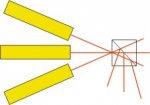zxn474l
0
- Joined
- Jan 11, 2009
- Messages
- 204
- Points
- 0
I have been told over and over that you can not use more than one "cube" to get 2 lasers to be joined into one..OK...but what if you used that same principle using small brass housings for pen style lasers and connected four lasers on one side each seperately collimated facing one side of the cube...and use four lasers set up in the same fashion on the other side of the cube with each diode producing 250mw+ 650nm red laser light stacked in a "square" pattern on each side lining up with the other in a tight square pattern so the 4 beams on one side of the cube combine with the 4 beams on the other side of the cube to produce a Doubled Power Output comming out of the cube with 4 beams each leaving the cube around 500mw each collimated close together and have the final 4 beams merge to a "focal" point using a simple adjustable lens to collimate the 4 beams to a point...NOT a single beam but a Single dot! That would be aproximatly 2 watts concentrated visible 650nm red laser light to burn with! the diodes would have to be fan cooled constantly to reduce heat and "cycled" on and off for brief periods to let the diodes cool down but that would work right!!!!!!!!!! LET ME KNOW IF THIS WILL INDEED WORK...BECAUSE I WANT TO BUILD SUCH A SYSTEM!






